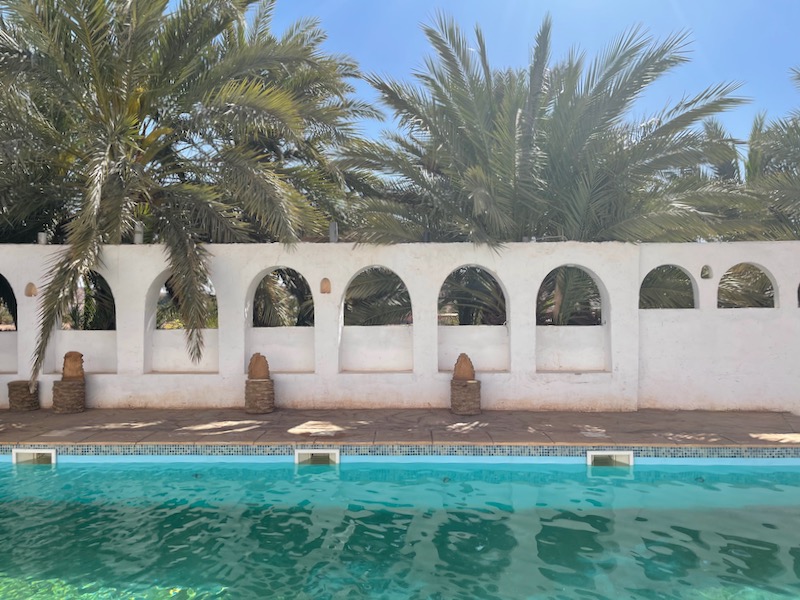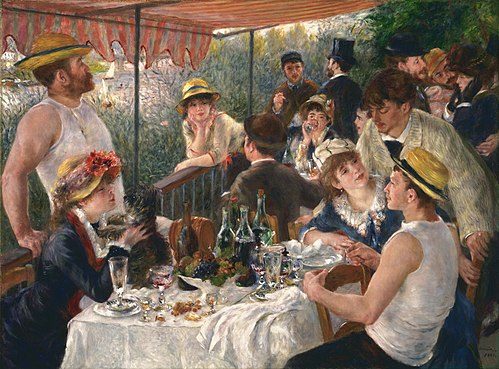Back in April of 2022, when we had only had several months remaining in Algeria, I knew that one place I did not want to miss was the southern Algerian city of Ghardaia, an oasis in the Sahara desert. I knew very little about it, except for the rug vendors who set up at the embassies in Algiers were all from Ghardaia. If Ghardaia was home to the rugs, then that is where I had to go.
Adam and flew from Algiers to Ghardaia on a Thursday during Ramadan. Passengers broke their fasts on the plane with dates and milk and small sandwiches. Our guide Slimane picked us up and took us to the guest house he owns, called Gite Tarist. I couldn’t see much of the town on the drive, but noticed small groups of men gathered on the roads from the tiny airport to the guest house to eat sandwiches and meat skewers. The driveway to the guest house is one long palm grove and then a modest white adobe structure.
The following morning, I really saw how pretty Gite Tarist is with all of its sun dappled surfaces, palm trees, and gentle arches.





Slimane (reachable at +213 551-919-100) who ended up being our personal tour guide for the weekend, drove us through Ghardaia to the village of El Atteuf. I couldn’t quite grasp the entire situation at the time, my French being only so-so and with Slimane and Adam speaking bits of Arabic, but turns out there are several closed religious villages in Ghardaia that only allow outsiders in if they take a tour with a guide from the village. So Slimane handed us off to Omar, who was helming the tourist office, which looked like a small two-story castle at a beach, complete with a sand floor. Us with our feet in the sand for a bit and he told us the history of the village. Ghardaia was built almost a thousand years ago by the Mozabites, an Ibadi sect of Berber (also called Amazigh) Muslims. It’s the only place in Algeria where women who are part of the Ibadi sect shroud themselves entirely in white cloth with only a single-eye exposed, earning them the moniker of Ghardaia’s “One-Eyed Women.” Of course you’re not supposed to take photos of the one-eyed women, Omar told us. Still I tried during our languorous tour around El Atteuf. But more than my desire to see the women, I was curious what they see through the aperture in their white sheet, clasped about them with both hands, just one eye peering out into the world. Just this village is their world. And it’s a tiny village and was not at all bustling relatively early on a Friday during Ramadan. Everyone was fasting and there was nary a food smell yet, and there were very few people walking around. But still, it was quite a photogenic little village, with all the curved doorways, domed rooftops and lovely pinks, terracottas and whites.








Slimane drove us back to Gite Tarist for lunch as there were no places in town that were open to the public, since Muslims fast from sunup to sundown during Ramadan. It felt disrespectful to be eating and drinking water in the presence of people who were fasting, but I also appreciated Slimane’s efforts to feed his non-fasting guests.
Following our lunch, he drove us to another village, Beni Isguen, which was a similar set-up: Drop us with a village local for a slow-paced stroll around walled village that is home to an insular society. To be honest, I had to dig deep to muster enthusiasm to, for the second time that day, be led around by a religious man telling me in French how wonderful his community is as a plainclothes Algerian officer followed close behind. But this is how tourism works in Ghardaia, and so it was what it was. I tried to focus on our guide’s words about what a harmonious society this village is, which is home to fewer than 7,000 inhabitants. The architecture works in harmony with nature by using all natural building materials that keep inhabitants cool in the heat of the desert. There is a village committee that comes to a consensus on rules, and those rules are gladly followed by the townspeople, said our guide. One of those rules is no jeans. Instead of jeans, most of the men wear harem pants with an astounding number of tiny pleats on the dropcrotch. (Sidenote: I coveted these mens-only pants and regret not buying a pair. Shortly after this trip, an American friend sported a pair she’d bought on her trip to Ghardaia and she looked cool as hell). It became increasingly difficult for me to believe this man that the inhabitants of Beni Isguen had collaboratively created a utopia when I’d not seen any women. We approached a tower and I started to ascend, hoping to get a birds-eye photo into the cell-like homes below – the French philosopher Simone de Beauvoir called Ghardaia a “Cubist painting beautifully constructed” — but was told outsiders couldn’t climb the tower on Fridays because that is when the village women are on the rooftop doing laundry and customs demand privacy for them. Oh laundry day, that sacred day of womanly delights and freedom. I entered a very familiar mental loop that goes like this:
Where are all the women?/Oh all the women are inside their homes. That’s sad. Why can’t women be in public?/Okay Emily, you’re projecting. Your way is not the only way. Be open. Don’t be judgmental/But aren’t women in public a sign of an equal society? Isn’t equality of the genders an objectively good thing?
We entered a town square and I was relieved to see at least some girls playing games in groups and a woman leading what looked like an elementary school lesson. It was the first bustle in these villages and I wanted to capture it, but our guide was very aware that I wanted to take pictures of people and he made it clear he disapproved.
I kept thinking of similarities between these closed religious societies and those of the Ultra-Orthodox Jews in Jerusalem including their adherence to very traditional gender roles, intermarriage, eschewing many modern ways of living, and being closed off to outsiders. Both Ghardaia village tours didn’t reveal much about how people live today, which is always what interests me most, unlike the profoundly moving tour of Jerusalem’s Ultra-Orthodox Mea Sherim community with a man who’d left that community several years prior.





Sunset comes late in the Sahara and it was still not time to break the fast after the second village tour. Slimane drove us to small zoo and if I was already disturbed by a lack of women, seeing scraggly lions in cages didn’t help my mood or mindset. We also visited a little oasis park/playground area and then a more modern neighborhood and were even given a tour of a model home as if we were a young Algerian couple considering laying down roots.



When we returned to Gite Tarist, it was time for dinner, and we had some company: A domesticated desert fox, or fennec, which looks like a cross between a fox an a chihuahua, was scurrying about the room. For unknown reasons, his name is Mike. It was such a vibe: Wall-to-wall (and even up the wall) rugs of pink, red, yellow, and black, some with designs that symbolize a pot of couscous, a desert sun, the joining of two families. Musk incense in the air flavoring out Hamoud pop, okay I’ll be honest our gin and Hamoud.


The next day’s itinerary was mercifully free of guided tours. We went to Ghardaia’s old souk with its sand-colored and pink adobe-style buildings punctuated with rising minarets, arched doorways, and colorful rugs. It was a movie set of a scene and reminiscent of Marrakech, only much smaller. We were told that Marrakech was actually modeled off of Ghardaia.



I came here for those storied rugs. (Read this blog post for my favorite-ever rug shopping experience). We assalam alakumed the shopkeepers and climb stairs and they unfurled enormous old colorful rugs, not saying much about each, letting the products speak for themselves. It was great fun. And although inquiring about prices brought the same difficulties in translation as always, what I gathered was the vintage rugs were cheaper because they were old, which is the opposite of how it usually works. I think we saw all the rugs in the fairly modest medina and ultimately picked a rather 1960s looking purple number with geometric flowers on it. It’s probably 7×12 and it cost maybe $200. I also bought a brown, black, white, and gray one, which is not usually my color palette but I knew I liked it and it looked good wrapped tight around the upholstered headboard in our Algiers guest bedroom.






After the rugs, we entered the food market area, thrusting ourselves in the thick of the main pedestrian thoroughfare and letting the flow of foot traffic carry us along. We knew we lost our guide and the plainclothes police following us and I just did not care. The thrum of being an anonymous shopper in a North African market was thrilling. “I’ve missed this!” I said aloud, and remembered how much I’d loved getting lost in markets Rabat, Fez, and Jerusalem.
Unlike those markets, the Ghardaia one is pristine. Not a wrapper on the ground, not a speck of dirt on the beets even. I admired the way the light tie-died the carrot greens, I pondered the many uses for the date, and wondered if an armful of swiss chard would travel well back to Algiers. I was on the lookout for fresh basil, which I rarely found in Algiers. I didn’t end up finding any myself, but Slimane generously procured a massive bouquet, which I happily brought back to Algiers.







After one last meal at Gite Tarist (quite good food and very accommodating to vegetarians) we were back at the airport, two rugs in tow, some date products, a massive bunch of basil. It was really a perfect Algeria weekend trip: not very hard to get to, a kind host, interacting with a spunky desert fox, a comfy place to stay, good food, history and culture, and shopping.
To Ghardaia,
Emily

Thanks for this post on Ghardaia! I had looked into it and reading through the lines of some people’s blog posts about it, I got the feeling that you conveyed far more directly. I get that travel bloggers have to be positive about basically everything, so it is nice to read about a trip here by someone who isn’t a professional travel blogger.
Thanks for saying that! It’s always a balance between my writerly and my diplomatic sides. But honest travel writing is the only kind worth doing. Otherwise, it’s just marketing copy.